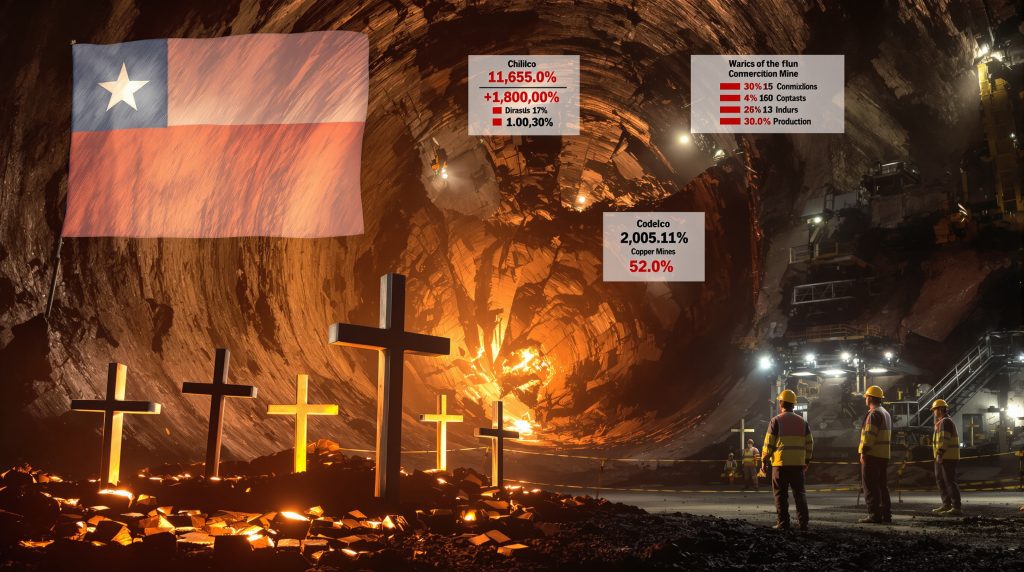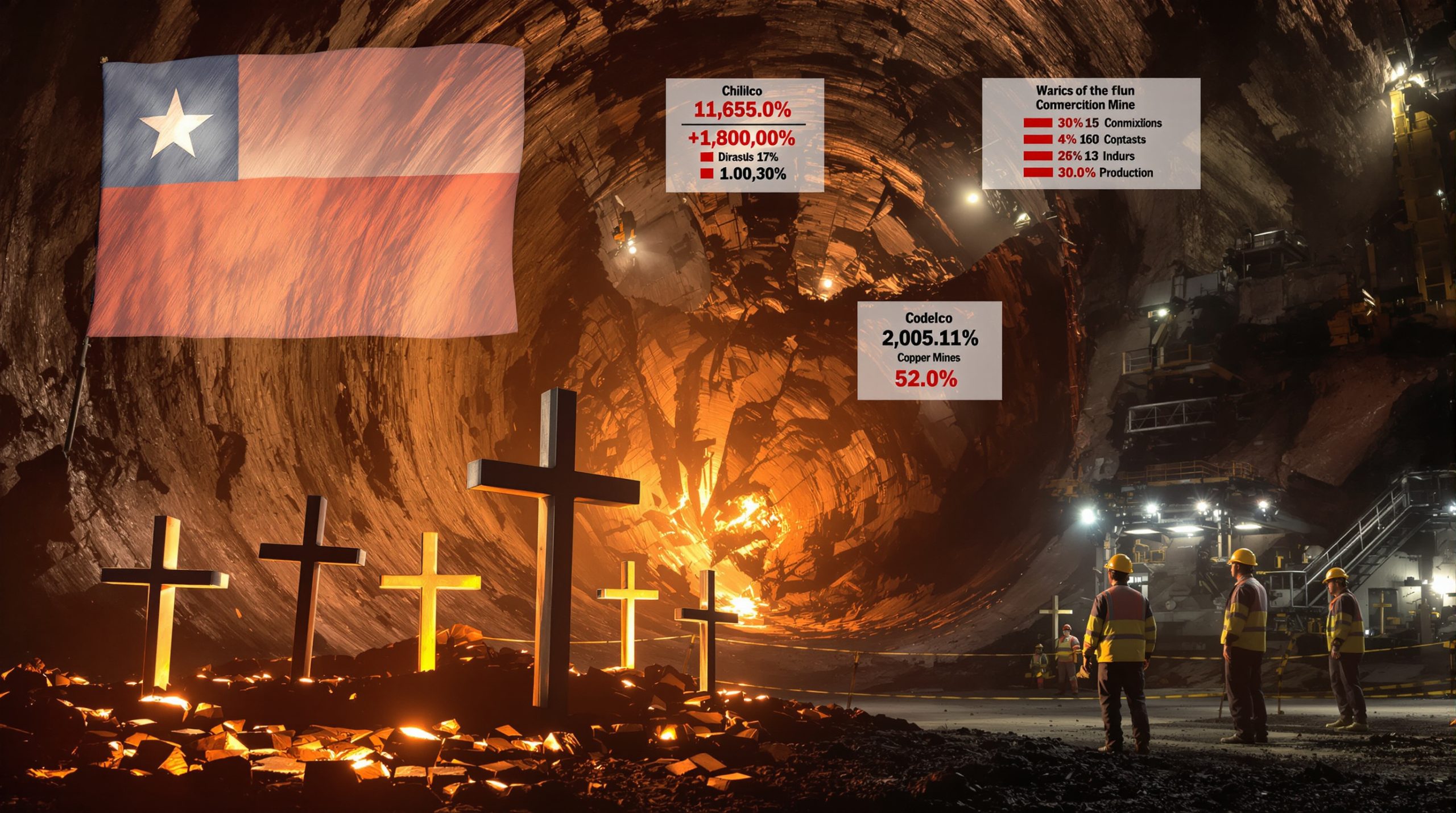El Teniente Accident's Impact on Codelco's Copper Production Goals
The July 31 accident at Codelco's El Teniente copper mine resulted in six fatalities and triggered a complete operational shutdown, creating significant ripple effects across Chile's copper industry. The incident, which occurred in the mine's Andesita section, has forced production suspensions pending thorough safety investigations. This catastrophic event carries implications extending beyond worker safety to impact Chile's copper production capabilities and Codelco's financial outlook for the coming year.
Understanding the Strategic Importance of El Teniente
El Teniente stands as one of the world's largest underground copper operations and represents Codelco's flagship asset. Located in central Chile approximately 80 kilometers south of Santiago, this century-old mine has been a cornerstone of the state-owned company's production portfolio for decades.
Historically, El Teniente contributes approximately 400,000 tonnes of copper annually, representing nearly 30% of Codelco's total output. The mine employs over 4,000 workers and utilizes sophisticated block-caving techniques to extract copper from increasingly deeper ore bodies.
The mine's strategic importance to global copper supply forecast makes any disruption particularly significant, as it supplies approximately 2% of global copper production. With copper being critical to electrification, renewable energy, and construction sectors, supply disruptions at major operations like El Teniente can influence market sentiment and pricing dynamics worldwide.
Production Setbacks and Financial Implications
Revised Production Forecasts Following the Accident
Following the incident, Codelco has substantially revised El Teniente's 2025 production guidance downward to approximately 316,000 tonnes of copper. This represents a significant reduction from initial targets and translates to a production loss between 20,000-33,000 metric tonnes for the year.
Industry analysts estimate this shortfall could result in financial losses ranging from $300-340 million for the already debt-burdened state miner. With copper prices currently hovering around $4.89 per pound, the revenue impact is substantial at a time when Codelco needs strong cash flow to support its ambitious modernization programs.
The immediate financial implications extend beyond direct production losses to include:
- Increased maintenance and safety remediation costs
- Higher labor expenses during the recovery period
- Potential contractual penalties for supply disruptions
- Insurance premium increases following the safety incident
- Additional regulatory compliance expenses
Impact on Codelco's Broader Production Recovery Strategy
Prior to the accident, Codelco had targeted total 2025 copper production of approximately 1.39 million metric tonnes, representing a modest increase from previous years. This goal was part of a comprehensive strategy to reverse several years of declining output.
The company's longer-term ambition to return to its 2020-2021 production levels of 1.6 million tonnes annually now faces a substantial obstacle. Mining analysts point out that production disruptions at flagship operations like El Teniente create compound effects across operations, as resources must be redirected and management attention diverted to recovery efforts.
Codelco's production challenges come at a particularly sensitive time for global copper markets, with many analysts forecasting a supply deficit in the coming years due to growing surging copper demand from renewable energy, electric vehicles, and infrastructure projects worldwide.
Moody's Assessment and Market Reactions
Credit Rating Implications Despite Bond Issuance
While Moody's maintained its credit rating and stable outlook for Codelco following the accident, the ratings agency explicitly stated that the operational disruption carries negative credit implications. This assessment came as Codelco announced a $1.4 billion bond issuance in two tranches, with maturities in 2035 and 2055.
The successful bond placement demonstrates that Codelco retains access to capital markets despite operational challenges. However, the yield spread on these bonds compared to US Treasuries indicates that investors are demanding higher premiums to account for operational and financial risks.
Market analysts note that Codelco's total debt burden exceeded $17.5 billion before this latest bond issuance, highlighting the financial pressures facing the state mining giant as it simultaneously manages existing operations, invests in modernization, and addresses safety concerns.
Investor Confidence and Debt Reduction Challenges
Moody's has emphasized that upward rating pressure for Codelco would depend on the state-run company's ability to reduce its substantial debt burden. The production setback at El Teniente complicates this objective by potentially reducing cash flow available for debt servicing.
Market analysts are closely monitoring how this production shortfall might affect investor confidence in Codelco's debt management strategy. Several key metrics deserve attention:
- Debt-to-EBITDA ratios, which had been improving prior to the accident
- Free cash flow generation capabilities during the recovery period
- Capital expenditure requirements for safety improvements
- Potential government support mechanisms, given Codelco's strategic importance to Chile
The timing of the incident is particularly challenging as it coincides with a period of significant capital investment requirements across Codelco's aging asset base.
Technical and Operational Recovery Challenges
Mine Safety Investigations and Restart Timeline
Before operations can fully resume at El Teniente, comprehensive safety investigations must be completed and new protocols implemented. The Andesita section, where the accident occurred, faces particularly stringent scrutiny from both internal safety teams and external regulatory authorities.
Engineering teams must assess tunnel integrity, implement reinforcement measures, and receive regulatory clearance—a process that typically extends for months following major mining incidents. The investigation will likely involve:
- Detailed structural assessments of affected tunnel sections
- Review of rock mechanics and geotechnical monitoring systems
- Evaluation of ventilation systems and emergency response procedures
- Assessment of employee training and safety protocol adherence
- Implementation of enhanced safety measures before restart approval
Chilean mining regulations require formal approval from SERNAGEOMIN (the National Geology and Mining Service) before suspended operations can resume, adding another layer of compliance requirements to the recovery process.
Infrastructure Repairs and Production Ramp-Up Constraints
Beyond safety clearances, the physical repair of damaged infrastructure presents additional challenges. Underground mining operations require careful sequencing of development and production activities, meaning that even after approvals are secured, a gradual ramp-up period will be necessary.
Block caving operations like those at El Teniente involve complex cave propagation dynamics that can be disrupted by extended production stoppages. Mining engineers must carefully manage the restart to avoid issues like:
- Unexpected cave freeze or hang-ups requiring additional development work
- Degradation of existing underground infrastructure during the shutdown
- Loss of skilled personnel during extended suspension periods
- Equipment recertification and maintenance requirements
- Re-establishing efficient materials handling systems underground
Industry experience suggests that full recovery of production rates after major incidents can take 6-12 months, even after safety clearances are obtained.
Broader Industry and Market Implications
Effects on Global Copper Supply and Price Dynamics
The production shortfall at one of the world's premier copper mines occurs amid tight global copper supplies and growing demand from electrification and renewable energy sectors. While the El Teniente disruption alone is unlikely to dramatically shift global copper prices, it contributes to an overall supply constraint narrative.
Current copper price prediction fundamentals include:
- Global warehouse inventories at multi-year lows
- Ongoing operational challenges at several major copper producers
- Increasing demand from renewable energy and electric vehicle sectors
- Limited new major projects coming online in the near term
These factors collectively support price stability or potential increases in the near term. The El Teniente disruption adds to this backdrop of constrained supply, potentially providing additional price support for copper producers with unaffected operations.
Chile's Position in the Global Copper Market
Chile remains the world's largest copper producer, with Codelco as its flagship mining company. The El Teniente incident raises questions about Chile's ability to maintain market share as competitors in Peru, Australia, and the Democratic Republic of Congo expand production.
National production statistics will likely show the impact of this disruption in quarterly reports through late 2025 and potentially into 2026. Chile's copper industry also faces broader challenges including:
- Declining ore grades across mature mining districts
- Water scarcity in key northern mining regions
- Growing community opposition to new mining developments
- Higher energy costs affecting operational expenses
- Evolving regulatory requirements for environmental compliance
These structural challenges, combined with operational incidents like the El Teniente accident, create headwinds for Chile's ambitions to maintain its dominant position in global copper markets.
Long-Term Recovery Strategies and Outlook
Codelco's Path to Production Target Achievement
Despite the setback, Codelco maintains its long-term strategic objective of returning to 1.6 million tonnes of annual copper production. However, the timeline for achieving this target will likely shift. Industry analysts now project that reaching this benchmark may be delayed by 6-12 months, pushing full recovery into late 2026 or early 2027, depending on remediation progress at El Teniente.
The company's recovery strategy likely includes:
- Accelerating development in alternative production sectors at El Teniente
- Optimizing production at unaffected operations to partially offset losses
- Implementing advanced technologies to improve recovery rates and operational efficiency
- Revising capital allocation priorities to focus on high-return, near-term opportunities
- Strengthening preventative maintenance programs across all operations
The success of these initiatives will depend on Codelco's ability to balance immediate operational recovery with longer-term strategic objectives while maintaining financial discipline.
Capital Investment Requirements for Recovery
Addressing the aftermath of the accident will require additional capital expenditure beyond Codelco's planned investment program. These unexpected costs come at a challenging time for the state miner, which is already executing an ambitious $40 billion, 10-year investment plan to extend the life of its aging mines and boost production efficiency.
Key capital requirements will include:
- Emergency infrastructure repairs at the affected Andesita section
- Enhanced safety systems implementation across underground operations
- Accelerated development of alternative production areas to replace lost output
- Technology upgrades to improve monitoring and early warning capabilities
- Training and human resources investments to strengthen safety culture
These requirements create additional pressure on Codelco's already stretched capital budget and may necessitate prioritization decisions regarding other planned projects.
Safety Protocols and Regulatory Response
Regulatory Oversight and New Safety Measures
Chile's mining regulators have intensified scrutiny of all Codelco operations following the El Teniente accident. The company faces potential regulatory requirements to implement enhanced safety protocols across its entire portfolio of mines.
These measures, while essential for worker protection, may temporarily reduce operational efficiency and increase production costs. Potential regulatory responses include:
- Mandatory implementation of advanced geotechnical monitoring systems
- Increased frequency of safety inspections and compliance audits
- Enhanced training requirements for underground personnel
- Stricter protocols for tunnel support and ground control
- More conservative operating parameters in high-risk areas
Chilean mining authorities have historically maintained some of Latin America's most rigorous safety standards, and this incident may trigger further regulatory evolution.
Industry-Wide Safety Implications for Chilean Mining
The incident has prompted broader discussions about safety standards throughout Chile's mining sector. Industry associations and labor unions are calling for comprehensive reviews of underground mining practices, potentially leading to new regulations that could affect production capabilities across multiple operations in the country.
The broader implications for Chilean mining include:
- Greater emphasis on predictive maintenance and early warning systems
- Increased adoption of automation technologies to reduce human exposure to high-risk areas
- Enhanced collaboration between operators on safety best practices
- Evolution of industry standards for underground support systems
- Greater investment in specialized training for underground mining personnel
These developments may accelerate the industry's technological transformation while creating short-term operational adjustments across Chile's mining sector.
Future Outlook and Risk Mitigation
Strategic Adaptations for Long-Term Resilience
Looking beyond the immediate recovery period, Codelco will likely implement strategic changes to build greater operational resilience. Industry experts suggest several potential approaches:
- Diversification of production across more operational areas to reduce concentration risk
- Accelerated adoption of remote operations and automation technologies
- Enhanced integration of real-time monitoring and predictive analytics
- Development of more flexible production plans that can adapt to disruptions
- Greater emphasis on comprehensive risk assessment and scenario planning
These adaptations align with broader industry trends toward building more resilient and technologically advanced mining operations capable of navigating increasingly complex operational, social, and environmental challenges.
Balancing Production Recovery with Safety Imperatives
The El Teniente recovery process highlights the fundamental tension between production targets and safety imperatives that mining companies must navigate. Successful recovery will require Codelco to:
- Establish clear safety-first principles that guide all recovery decisions
- Implement transparent communication with stakeholders about recovery progress
- Set realistic production expectations that acknowledge safety constraints
- Invest in technologies that enhance both safety and productivity
- Build a stronger safety culture that empowers workers to identify and address risks
How Codelco navigates this balance will influence not only its own operational recovery but may set important precedents for how major mining companies respond to safety incidents in an era of increasing stakeholder scrutiny.
FAQ: El Teniente Accident and Codelco Production
What caused the accident at El Teniente mine?
The exact cause of the July 31 accident remains under investigation by Chilean authorities and Codelco's safety teams. Initial reports suggest structural issues in the Andesita section of the underground mine may have contributed to the incident that resulted in six fatalities.
How much copper production has been lost due to the El Teniente accident?
Current estimates indicate a production loss of between 20,000-33,000 metric tonnes of copper, representing approximately 20-25% of El Teniente's planned annual output for 2025.
Will the El Teniente accident affect global copper prices?
While the production disruption is significant for Codelco, it represents a relatively small percentage of global copper supply. However, combined with other supply constraints worldwide, it contributes to an overall tightening market that supports stable to higher copper prices in the near term.
When will El Teniente return to full production capacity?
Complete recovery to pre-accident production levels will likely take 6-12 months, with gradual resumption of operations expected to begin in phases following safety clearances and infrastructure repairs.
How is Codelco addressing its financial challenges while managing the accident recovery?
Codelco continues to access capital markets, as evidenced by its recent $1.4 billion bond issuance. The company is likely implementing cost control measures across unaffected operations while prioritizing capital allocation to support El Teniente's recovery and maintain essential modernization projects.
What are the implications for Chile's copper industry leadership?
While this incident creates short-term challenges, Chile's fundamental advantages in copper mining remain strong. However, the country's mining sector must address declining ore grades, water constraints, and safety challenges to maintain its competitive position against gold and copper exploration trends and copper & uranium investments globally.
Looking to Stay Ahead of Major Mining Discoveries?
Discover real-time alerts on significant ASX mineral discoveries with Discovery Alert's proprietary Discovery IQ model, turning complex mining data into actionable investment insights. Explore why historic discoveries generate substantial returns by visiting the dedicated discoveries page and begin your 30-day free trial today for a market-leading advantage.




